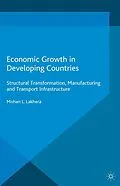Economic growth across countries during the last 30 years or so has displayed 'dual' divergence between developed and developing countries, and among developing countries. The structural transformation has been either slow or of an anomalous nature. The study addresses these and suggests how they can catch-up with developed world.
Autorentext
Mohan L. Lakhera, a former member of the Indian Economic Service, has had a distinguished academic and professional career, contributing papers to leading economic journals and winning several awards. He has held advisory positions in different ministries of the Government of India including that of Economic Advisor. He was a fellow at the School of Economics, Nagoya University and Institute of Developing Economies, Tokyo, Japan. He has also held several academic positions as a researcher, professor and visiting faculty at several academic institutions. His earlier book Japanese FDI Flows in Asia: Perspectives and Challenges was published by Palgrave in 2008.
Inhalt
PART I: INTRODUCTION: TOWARDS AN EXPLANATION OF UNEVEN GROWTH EXPERIENCES 1.1 Context And Motivation 1.2 Uneven Growth -Broad Empirical Results About the Book 1.3 Major Goals 1.4 Chapter Planning - Contents 1.5 Design And Methodology PART II: DETERMINANTS OF ECONOMIC GROWTH IN DEVELOPING ECONOMIES 2.1 Introduction 2.2 Theoretical Discussion: A Brief Survey 2.3 The 'Miracle' Economies' Approaches 2.4 Identification Of Potential Economic Determinants 2.5 The Econometric Model 2.6 Concluding Remarks PART III: GROWTH AND STRUCTURAL TRANSFORMATION - MAJOR ASIAN COUNTRIES' EXPERIENCES 3.1 Introduction 3.2 Structural Transformation - Some Stylized Facts 3.3 Policy Choices And Identification Of Priorities 3.4 Paths To Structural Transformation 3.5 Structural Transformation In Asia 3.6 India And China: Compared 3.7 Growth And Structural Changes: Evidence On India 3.8 Concluding Remarks PART IV: MANUFACTURING: DIVERSIFICATION AND SOPHISTICATION 4.1 Introduction 4.2 'Lessons' Emerging From Manufacturing Growth Path: Key Generalizations 4.3 Diversification And Sophistication 4.4 Economic Thresholds For Industrialization And High-Income Status 4.5 International Manufacturing Scenario 4.6 Acquiring Capabilities For Manufacturing 4.7 India, East Asia And China: A Brief Comparison 4.8 India's Decelerated Manufacturing Performance 4.9 Concluding Remarks PART V: PRODUCTIVITY GROWTH EXPERIENCES IN THE MANUFACTURING SECTOR 5.1 Introduction 5.2 Some Stylized Facts About Productivity Growth 5.3 Productivity Growth Drivers In Different Periods In Successful Economies 5.4 Cross-Country Picture 5.5 Estimation Of Total Factor Productivity Growth In India's Manufacturing Sector 5.6 Results Of TFPG 5.7 Comparison With Other Estimates 5.8 Determinants Of TFPG 5.9 Concluding Remarks PART VI: TRANSPORT INFRASTRUCTURE FOR SUSTAINED GROWTH 6.1 Introduction 6.2 Some Key Generalizations Transport Cost 6.3 Review Of Select Empirical Evidences 6.4 Impact Of Infrastructure On MVA In India 6.5 Transport Logistics Costs And Global Production Network 6.6 Cost Minimization 6.7 Improving The Cost Effectiveness Of Investment 6.8 Challenges 6.9 The Indian Scenario 6.10 Concluding Remarks PART VII: MAJOR FINDINGS, CHALLENGES, AND OPPORTUNITIES 7.1 Major Findings 7.2 Challenges And Opportunities 7.3 Final Remarks Technical Annex References
